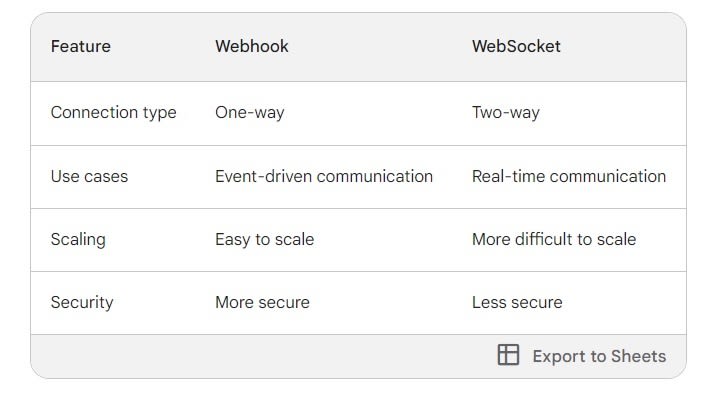Webhooks and WebSockets are both web technologies that allow for real-time communication between applications. However, they have different strengths and weaknesses, and are best suited for different use cases.
Webhooks are one-way connections that allow an application to send data to another application. When an event occurs in the first application, a webhook is triggered and sends data to the second application. Webhooks are typically used for event-driven communication, such as when a user signs up for a newsletter or makes a purchase.
WebSockets are two-way connections that allow applications to communicate with each other in real time. WebSockets are typically used for applications that require constant communication, such as chat applications or multiplayer games.
Here is a table summarizing the key differences between webhooks and WebSockets:
When to use webhooks:
- When you need to send data from one application to another in a one-way fashion.
- When you need to ensure that the data is delivered reliably.
- When you need to scale the communication easily.
When to use WebSockets:
- When you need to communicate with another application in real time.
- When you need to send a lot of data between applications.
- When you need to ensure that the communication is secure.
- In general, webhooks are a good choice for applications that need to send data from one application to another in a reliable and scalable way.
WebSockets are a good choice for applications that need to communicate with another application in real time and send a lot of data.
Here are some examples of applications that use webhooks:
- Email marketing applications: When a user signs up for an email list, the email marketing application can send a webhook to a CRM application to create a new contact record.
- Payment processing applications: When a user makes a purchase, the payment processing application can send a webhook to an inventory management application to update the product stock levels.
- Chat applications: When a user sends a message in a chat application, the chat application can send a webhook to a notification service to send a notification to the recipient.
Here are some examples of applications that use WebSockets:
- Chat applications: Chat applications use WebSockets to allow users to communicate with each other in real time.
- Multiplayer games: Multiplayer games use WebSockets to allow players to interact with each other in real time.
- Stock trading applications: Stock trading applications use WebSockets to get real-time updates on stock prices.



Top comments (0)